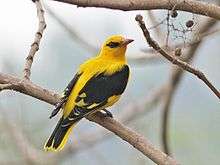Indian golden oriole
| Indian golden oriole | |
|---|---|
 | |
 | |
| Adult male (above), female (below) | |
| Scientific classification | |
| Kingdom: | Animalia |
| Phylum: | Chordata |
| Class: | Aves |
| Order: | Passeriformes |
| Family: | Oriolidae |
| Genus: | Oriolus |
| Species: | O. kundoo |
| Binomial name | |
| Oriolus kundoo Sykes, 1832 | |
 | |
| Approximate distribution | |
| Synonyms[2] | |
| |
The Indian golden oriole (Oriolus kundoo) is a species of oriole found in the Indian subcontinent and Central Asia. The species was formerly considered to be a subspecies of the Eurasian golden oriole, but is now considered a full species. Adults can be told apart from the Eurasian golden oriole by the black of the eye stripe extending behind the eye.
Taxonomy and systematics
Formerly, the Indian golden oriole was considered as a subspecies of the Eurasian golden oriole until split in 2011 based on differences in morphology, plumage, calls and the fact that the two do not intergrade.[3][4] A sub-population named baltistanicus was considered by Charles Vaurie to be indistinguishable from O. o. kundoo.[5]
Description
_on_nest_W_IMG_9050.jpg)
The Indian golden oriole is very similar to the Eurasian golden oriole but has more yellow in the tail and has a paler shade of red in the iris and bill. The male has the black eye stripe extending behind the eye, a large carpal patch on the wing and wide yellow tips to the secondaries and tertiaries. The streaks on the underside of females is more sharp than in the females of the Eurasian golden oriole.[6][7][8] The European species is larger with a wing length of 149–162 mm in adult males compared to 136–144 mm in O. kundoo. The wing formula is also different with primary 2 longer than 5 in O. oriolus while primary 5 is longer than 2 in O. kundoo.
Distribution and habitat
This oriole breeds from Baluchistan and Afghanistan along the Himalayas to Nepal. Some populations breed in the peninsular region but are very local. The northern populations winter in southern India, with some birds wintering in Sri Lanka. The populations that occur in the Maldives and the Andaman Islands have not been carefully examined.[6]
The Indian golden oriole inhabits a range of habitats including open deciduous forests, semi-evergreen forests, woodland, forest edge, mangroves, open country with scattered trees, parks, gardens orchards and plantations.[3]
.jpg)
Behaviour and ecology
Their flight is dipping but strong and has been recorded to reach about 40 km/h. They sometimes bathe by repeatedly flying into a small pool of water. An individual ringed in Gujarat was recovered in Tajikistan more than nine years later.[9]
Breeding
The Indian golden oriole is a partial migrant. It breeds in central Asia and the Indian subcontinent. The Indian populations are largely resident while the other populations are migratory.[3] The breeding season is April to August, the nest being a small cup placed in a fork near the end of a branch. Nests are often built in the vicinity of the nest of a black drongo.[6] Two or three white eggs with reddish, brown and black speckling form the typical clutch. Both parents take part in nest and brood care, defending the nest against intruding birds such as shikras and crows.[9]
Food and feeding
Orioles feed on fruits, nectar and insects.[6] They are capable of dispersing the seeds of many berry-bearing plants including the invasive Lantana camara.[10] An oriole has been recorded preying on southern flying lizards.[11]
Threats
A protozoal blood parasite, Haemoproteus orioli, described from this species has been suggested to occur in many oriole species[12] but may represent different lineages.[13]
References
- ↑ BirdLife International (2016). "Oriolus kundoo". IUCN Red List of Threatened Species. Version 2016.3. International Union for Conservation of Nature. Retrieved 25 February 2017.
- ↑ "Oriolus kundoo". Avibase.
- 1 2 3 Walther, B; Jones, P (2008). "Family Oriolidae (Orioles and Figbirds)". In Josep, del Hoyo; Andrew, Elliott; David, Christie. Handbook of the Birds of the World. Volume 13, Penduline-tits to Shrikes. Barcelona: Lynx Edicions. pp. 692–723. ISBN 978-84-96553-45-3
- ↑ Jønsson, K. A.; Bowie, R. C. K.; Moyle, R. G.; Irestedt, M.; Christidis, L.; Norman, J. A.; Fjeldsa, J. (2010). "Phylogeny and biogeography of Oriolidae (Aves: Passeriformes)" (PDF). Ecography. 33 (2): 232–241. doi:10.1111/j.1600-0587.2010.06167.x.
- ↑ Vaurie, Charles. "Systematic notes on Palearctic birds. No. 32, Oriolidae, Dicruridae, Bombycillidae, Pycnonotidae, Nectariniidae, and Zosteropidae". American Museum Novitates. 1869: 1–28.
- 1 2 3 4 Rasmussen PC; JC Anderton (2005). Birds of South Asia. The Ripley Guide. Volume 2. Washington DC & Barcelona: Smithsonian Institution and Lynx Edicions. p. 586.
- ↑ Jønsson, KA; Rauri C. K. Bowie, Robert G. Moyle, Martin Irestedt, Les Christidis, Janette A. Norman and Jon Fjeldsa (2010). "Phylogeny and biogeography of Oriolidae (Aves: Passeriformes)" (PDF). Ecography. 33: 232–241. doi:10.1111/j.1600-0587.2010.06167.x.
- ↑ Kollibay, Paul (1915). "Einige Bemerkungen über Oriolus oriolus kundoo Sykes". Journal of Ornithology (in German). 64 (2): 241–243. doi:10.1007/BF02250522.
- 1 2 Ali S; SD Ripley. Handbook of the Birds of India and Pakistan. Volume 5 (2 ed.). New Delhi: Oxford University Press. pp. 102–104.
- ↑ Ali, Salim (1936). "Economic ornithology in India" (PDF). Current Science. 4: 472–478.
- ↑ Balachandran, S (1998). "Golden oriole Oriolus oriolus preying on flying lizard Draco dussumieri Dum. & Bibr". J. Bombay Nat. Hist. Soc. 95 (1): 115.
- ↑ Peirce, MA (1984). "Haematozoa of Zambian birds VII. Redescription of Haemoproteus orioli from Oriolus oriolus (Oriolidae)". Journal of Natural History. 18 (5): 785–787. doi:10.1080/00222938400770651.
- ↑ Dimitrov, Dimitar; Pavel Zehtindjiev; Staffan Bensch (2010). "Genetic diversity of avian blood parasites in SE Europe: Cytochrome b lineages of the genera Plasmodium and Haemoproteus (Haemosporida) from Bulgaria". Acta Parasitologica. 55 (3): 201–209. doi:10.2478/s11686-010-0029-z.
